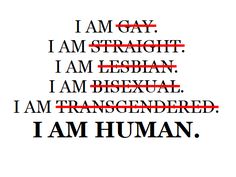As a group we thought we would do a quick write up on how the topic of LGBTA has helped us at educators or things we found interesting during our research!
All throughout High School I saw how awful students could be to their fellow classmates if they found out they were gay or thought they were. I could tell the teachers were uncomfortable whenever the comments were made because they weren’t sure how to address the situation. Our school didn’t have a Gay/Straight Alliance and this subject was never brought up. Today I have seen elementary aged children spout off the phrases, “That’s so gay” and “What a bunch of Lesbos” where in most cases the context isn’t close to being correct. This project has opened my eyes on how easy it is to place LGBTA teachings into the curriculum and even in Treaty Education. As a teacher I will do anything in my power to educate my students to be respectful and knowledgeable. With looking into the Treaty Education Outcomes and how it relates to LGBTA I was amazed to find out about people who are Two-Spirits and how they are honoured in First Nations culture. This shows much we are missing out on knowing and how ignorant people can be. I hope I can break through these barriers and misconceptions with the tools that I now have.
-Eden
Researching and educating myself about LGBTA was eye opening as well as something that will be a helpful tool in the future. Graduating from a small school, I can only remember one or two girls that were lesbians, although there could have been more that were not. Being only one or two people they had no one to turn to, no support, resulting in them being alone most of the time, isolating themselves from everyone else. Learning more about LGBTA and the importance of support systems such as a Gay/Straight Alliance has been helpful as a future educator. I hope to do whatever it takes to make every student I will have feel like they are of equal importance regardless of who they are.
“Fifty Shades of Gay” and “The Gay Agenda” are videos I believe that everyone should take time to look at. They both give an outstanding insight and are both very intriguing. They have both taught me to have a different outlook when it comes to LGBTA, and to be more open-minded.
-Kayla
I had no idea the great quantity of already prepared lesson plans and activities specifically designed to address LGBT topics within the classroom. With all of these great resources, it would seem as if it is the teachers that are holding back on approaching these topics within their classrooms. I began to wonder why it would seem that many teachers do not address LGBT topics. Are the vast majority of teachers unaware of the high quality lesson plans available about LGBT, or are they simply afraid to broach these controversial topics within the classroom? I feel that as Educators it is our duty to make ourselves aware of the resources available to us to help address such important social justice issues, and to be vigilant in our fight for equality and promotion of all ways of life.
-Shawn
Going into this project I found that I am not bias myself to the LGBTA community but the lack of support the community receives in schools is low. LGBTA students deserve the same treatment as any other students in the school that we as educators can provide to them. Watching the video “Fifty Shades of Gay”, opened my eyes to fact that people are labelled and that we need to have one box, called humans or people. On the inside all people are the same despite their sexual choices, it does not change who they are or want to be and as educators we need to help them to achieve their greatest potential.
-Jenelle
Going into this project I had no idea that Regina, or even Saskatchewan, had such a large LGBTQA community. I was honestly blown away when I started doing research on the subject. I had no idea that right in my own community there is an annual pride parade. Not only do we have an incredible community, but they are more than willing to talk to people and reach out to share their experiences.
-Adam

